The importance of diverse and inclusive picture books
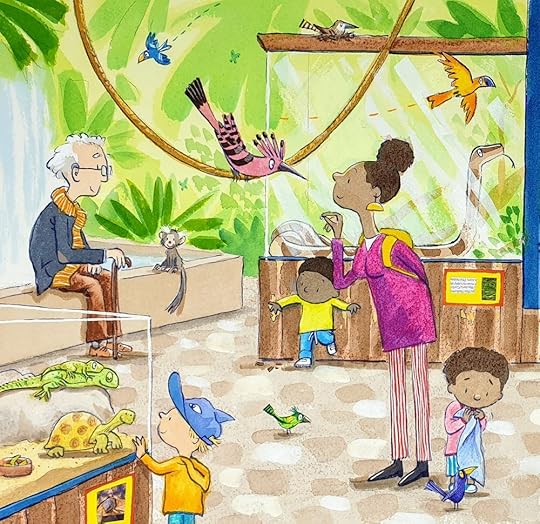
We’re seeing more and more disabled characters pop up in picture books. Maybe disability is finally having a moment.— James CatchpoleHere on my blog, I frequently discuss the importance of diversity in children’s books.
Here’s why:
1. It’s affirming. Kids have the right – and a need – to see themselves depicted in the books they read.
2. It develops understanding and empathy for others who are different from ourselves. Stories help us step into someone else’s shoes and see life from another perspective. (This applies to adults as well as kids!)
The conversation is usually centred around ethnic minorities. And in terms of racial diversity, picture books have improved significantly over the last few years.
Being inclusive of ethnic minorities is something I’ve consciously addressed in my work. For years, I managed to dodge the bullet simply because I declined all opportunities to illustrate people (aside from Santa) due to a lack of confidence in my drawing ability. So it wasn’t an issue. Until I was offered the job of illustrating I’m Going to Give you a Bear Hug! (Zonderkidz, 2016).
I based the lead character (a tousled, blonde-haired White boy) on my son, Levi. And I love the final illustrations. But all the time, I was aware of the need for better representation of kids from ethnic minorities in picture books and struggled with my decision. (Read more in my article, The importance of diversity in children’s books.)
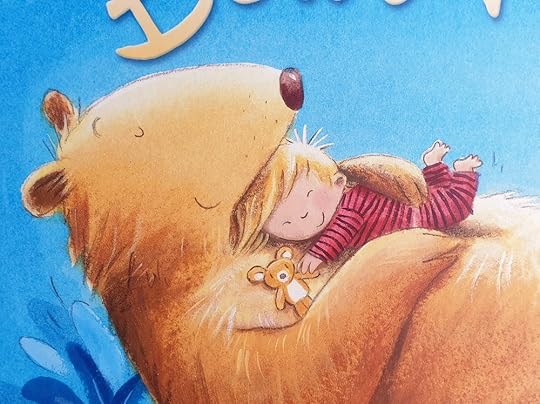
A few years later, I worked on the illustrations for Only You Can Be You! (Tommy Nelson, 2019). It was the perfect opportunity to show a diverse cast of characters! This was quickly followed by my illustrations for the follow-up to Bear Hug! This time around, there was no doubt in my mind about how to illustrate it. The resulting book, I Want To Give You a Polar Bear Hug! (Zonderkidz, 2020), features a Black family. I’m proud of my work, and rather than feeling tokenistic (as I’d feared), it felt (at least to me as the White creator) empowering.
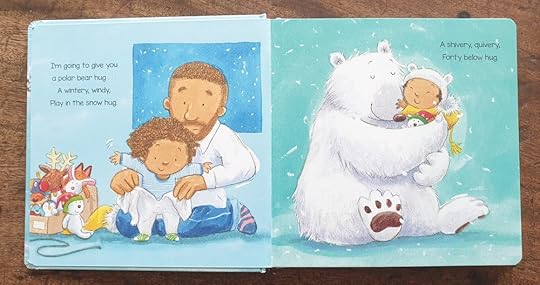
Diversity, of course, extends beyond the colour of someone’s skin or their ethnic group. So Only You Can Be You! features kids with glasses and kids with freckles and red hair. Neat and tidy kids and those who love the feel of paint on their bare feet! (Which reminds me – parents of neurodiverse kids have appreciated the book’s reassuring message: Everyone’s different, and that’s okay!)
And as we saw last week – disabled children need to see themselves represented, too. Which prompts a moment of self-reflection: How did I do with the cast of Only You Can Be You!?
Well, here’s my confession.
I intended to illustrate a child using a wheelchair.
I knew it was the right thing to do.
But, I’m embarrassed to say, I decided it was too hard to draw. (Pathetic, I know.) Instead, I tried taking the easy route and submitted my rough drawings to the publisher – wheelchair-free. Fortunately, the publisher insisted on including a wheelchair user.
In hindsight, I’m glad. The character was used to illustrate the line, Maybe you’re funny and tell silly jokes. It was a wise choice since it refers to a personality trait, thus acknowledging the kid as an individual rather than defining them by their disability. (For the record, yes – wheelchairs are tricky to draw!)
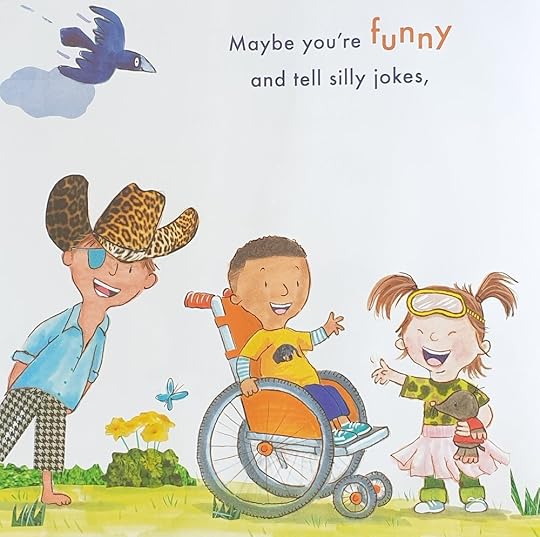
And amongst the kids in my original illustrations, there’s even a child wearing hearing aids (which I included at the publisher’s request). But curiously, I’ve just noticed that it was photoshopped out before going to print…
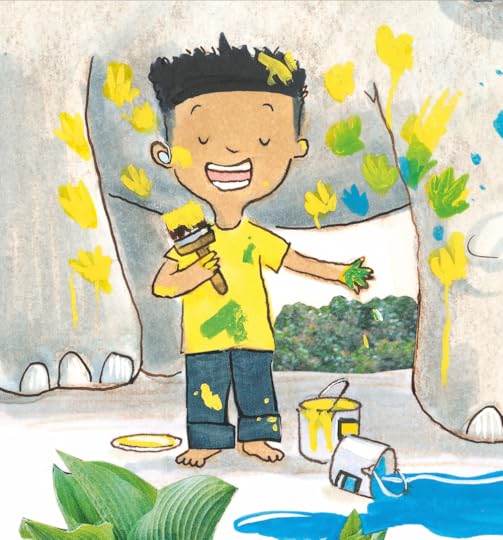
In hindsight, I wish I’d also thought of drawing a kid with a missing limb (like Joe in What Happened to You?). Or a kid using crutches.
Picture book creator Julie Flett was more thoughtful than I. Her delightful We All Play/ kimêtawânaw immediately ticks the diversity box with its inclusion of Cree words and children. But she also depicts a swimming child with a malformed arm. And why not? Because kids with disabilities (like Joe, the shark-fighting pirate!) like to play, too. There’s no comment or explanation. The child is simply there – an incidental but profound little detail, subtle enough that it might easily be overlooked.
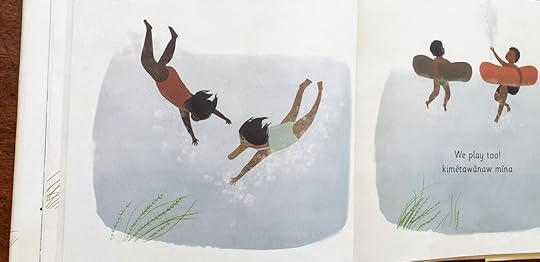
I’m still struck by how unusual it is for that to feature in a picture book. Curiosity aroused, I emailed Julie Flett and asked what led her to the decision to include the child?
Flett explained she’d been watching parasports, particularly swimming, when working on the book. Hence, the decision was natural and came about organically. (Encouragingly, Flett’s publisher, Greystone Books, ‘didn’t blink an eye.’)
But there’s empathy there, too: “I come from a community [Cree-Métis] who was not represented in kids books (or at least, not accurately), until recently,” she wrote. From personal experience, Flett understands the need to be accurately represented. She also acknowledged how far we’ve come along the road to diversity in picture books. “We have lots of books to share with kids now,” Flett writes. “And kids are seeing themselves in lots of different ways.”
As I write this, I realise the powerful effect reading What Happened to You? has had on me. It certainly did the trick that Catchpole hoped for: it put me in the shoes of a disabled child. As a result of the empathy I feel, it’s made me think hard about my future role as a creator of picture books. I’m left wondering: How can a non-disabled writer/illustrator be more inclusive of disabled characters?
I thought James Catchpole would be a wise person to ask, so I emailed him. I’ve summarised his excellent reply below (if you fit in the same category as me, I recommend you sit up and pay attention!):
Picturebooks can feature:
Disabled main characters.
Disabled secondary characters.
Disabled background characters.
The story can be about disability. (For example, What Happened to You?)
Or the disability can be incidental and not a particular feature. (For example, the children I’ve discussed from Only You Can Be You or We All Play.)
“Most picturebooks involving disability have been created by non-disabled people, and it shows,” wrote Catchpole. “They almost all get things wrong, and many of them do active harm (because no rep is better than bad rep). So, as a non-disabled author or illustrator, almost certainly best to stick to the last of these options: background inclusion on an incidental level.”
(Catchpole adds a caveat: Even that requires a degree of research.)
Catchpole’s insight has challenged me – and I’m excited about the possibilities that might open up as a result! But please bear in mind that making pictures books is a long, drawn-out process. So don’t hold your breath! But in a few years or so, I hope to have produced a picture book that somehow causes a disabled kid to feel represented and affirmed.

Thanks to James Catchpole and Julie Flett for their input.
For further info about disability in kids’ books, check out the Catchpoles’ articles:
Disability! Tips for illustrators, by real-life disabled publishing people
9 Unhelpful disability tropes in kids’ books
Illustration from It’s Bedtime, Charlie! © Tim Warnes (D Mind & the Prince, 2020)Illustration from I’m Going to Give You a Bear Hug! © Tim Warnes (Zonderkidz, 2016)Illustration from I’m Going To Give You a Polar Bear Hug! © Tim Warnes (Zonderkidz, 2020)Text excerpt from Only You Can Be You! © Nathan & Sally Clarkson (Tommy Nelson, 2019) Illustrations from Only You Can Be You! © Tim Warnes (Tommy Nelson, 2019)Illustration from We All Play / kimêtawânaw © Julie Flett 2021 (Greystone Kids, 2021)Illustration from What Happened to You? © Karen George 2021 (Faber & Faber, 2021)GOOD TO READPicture books that celebrate differencesWhat Happened to You? by James Catchpole and Karen George
Only You Can Be You! by Nathan and Sally Clarkson & Tim Warnes
Olivia by Ian Falconer
I Talk Like a River by Jordan Scott & Sydney Smith
DANGEROUS! by Tim Warnes
Naked Mole Rat Gets Dressed by Mo Willems
BUY THE BOOKPowered by Bookshop.org
Supporting independent bookshops
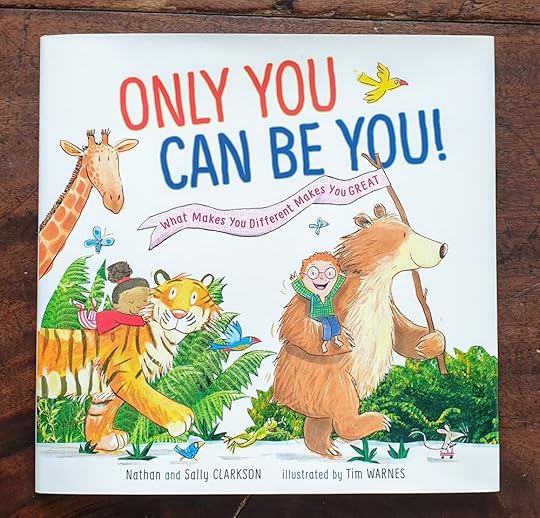 “[A book] that my daughter and I have truly enjoyed!”– Randi,
Modern Day Fairy Tale
“Beautiful pictures [that] will spark conversation with your kiddos.”– Brian D,
GoodReads
buy uk buy us * I EARN COMMISSION FROM THESE LINKS #AD/AFFRELATED ARTICLESSOURCESIt’s Bedtime, Charlie! by Tim Warnes (D Mind & the Prince, 2020)I’m Going to Give You a Bear Hug! by Caroline B Cooney, illustrated by Tim Warnes (Zonderkidz, 2016)I’m Going To Give You a Polar Bear Hug! by Caroline B Cooney, illustrated by Tim Warnes (Zonderkidz, 2020)Only You Can Be You! What Makes You Different Makes You Great! by Nathan and Sally Clarkson, illustrated by Tim Warnes (Tommy Nelson, 2019)What Happened to You? by James Catchpole, illustrated by Karen George (Faber & Faber, 2021)We All Play / kimêtawânaw by Julie Flett
(Greystone Kids, 2021)
The Current State of Disability Representation in Children’s Books
(Margaret Kingsbury, bookriot.com, 28 April 2021)
Disability! Tips for illustrators, by real life disabled publishing people
(Lucy and James Catchpole, 16 February 2022)© 2022 BY TIM WARNES(UNLESS OTHERWISE ATTRIBUTED)****USE OF THIRD PARTY COPYRIGHTED MATERIAL FALLS UNDER FAIR USE/FAIR DEALING PRACTICE.
“[A book] that my daughter and I have truly enjoyed!”– Randi,
Modern Day Fairy Tale
“Beautiful pictures [that] will spark conversation with your kiddos.”– Brian D,
GoodReads
buy uk buy us * I EARN COMMISSION FROM THESE LINKS #AD/AFFRELATED ARTICLESSOURCESIt’s Bedtime, Charlie! by Tim Warnes (D Mind & the Prince, 2020)I’m Going to Give You a Bear Hug! by Caroline B Cooney, illustrated by Tim Warnes (Zonderkidz, 2016)I’m Going To Give You a Polar Bear Hug! by Caroline B Cooney, illustrated by Tim Warnes (Zonderkidz, 2020)Only You Can Be You! What Makes You Different Makes You Great! by Nathan and Sally Clarkson, illustrated by Tim Warnes (Tommy Nelson, 2019)What Happened to You? by James Catchpole, illustrated by Karen George (Faber & Faber, 2021)We All Play / kimêtawânaw by Julie Flett
(Greystone Kids, 2021)
The Current State of Disability Representation in Children’s Books
(Margaret Kingsbury, bookriot.com, 28 April 2021)
Disability! Tips for illustrators, by real life disabled publishing people
(Lucy and James Catchpole, 16 February 2022)© 2022 BY TIM WARNES(UNLESS OTHERWISE ATTRIBUTED)****USE OF THIRD PARTY COPYRIGHTED MATERIAL FALLS UNDER FAIR USE/FAIR DEALING PRACTICE.
My Life in Books
For lovers of kid lit, this memoir - My Life in Books - is intended to give you the confidence and encouragement to share your own passion; to help you make lasting connections through kids’ books.
Originally posted at www.timwarnes.com ...more
- Tim Warnes's profile
- 30 followers



